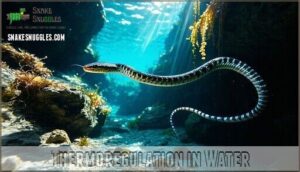This site is supported by our readers. We may earn a commission, at no cost to you, if you purchase through links.

These remarkable reptiles have mastered life both above and below the surface, with specialized adaptations that’ll surprise you.
Northern water snakes prefer slow-moving waters near sunny basking spots, while sea snakes venture into ocean depths.
Their flattened tails work like rudders, and some can hold their breath for hours underwater.
Whether it’s a backyard creek or coastal marsh, snake habitat in the water showcases nature’s incredible versatility.
These serpentine swimmers have evolved fascinating hunting techniques and survival strategies that make them true aquatic masters.
Table Of Contents
- Key Takeaways
- Aquatic Snake Habitats: Freshwater and Marine Environments
- Common Water Snake Species and Their Distributions
- Behavior and Adaptations of Aquatic Snakes
- Water Snake Ecology and Environmental Interactions
- Conservation and Management of Aquatic Snakes
- Frequently Asked Questions (FAQs)
- What is the common water snake habitat?
- What to feed a water snake?
- Are water snakes aggressive?
- How long do snakes live in water?
- Where do snakes live in the water?
- What snakes stay in water?
- What attracts snakes in water?
- How do water snakes hunt underwater?
- Can water snakes survive on land?
- Do water snakes hibernate during winter months?
- Conclusion
Key Takeaways
- You’ll find aquatic snakes in diverse water environments – from freshwater ponds and rivers to saltwater coastal areas and open oceans, with each species adapted to specific aquatic conditions and prey availability.
- These snakes have specialized physical adaptations for water life – including streamlined bodies for efficient swimming, flattened tails that work as rudders, enhanced lung capacity for extended underwater hunting, and waterproof skin.
- They play crucial ecological roles as both predators and prey – controlling fish and amphibian populations while serving as food for birds, larger fish, and mammals, making them essential indicators of healthy aquatic ecosystems.
- Water snake populations face serious conservation challenges – including habitat loss from development, water pollution affecting their prey, climate change altering their environments, and human persecution based on misidentification with venomous species.
Aquatic Snake Habitats: Freshwater and Marine Environments
You’ll find aquatic snakes thriving in an impressive range of watery habitats, from slow-moving rivers and sunny lakes to salty coastal marshes and even the open ocean, where some species spend their entire lives.
Aquatic snakes call everything from gentle rivers to wild ocean currents home, mastering waters where few others dare venture.
Whether you’re picturing a snake basking on a pond rock or hunting in a mangrove swamp, these reptiles have mastered environments that would leave most of us searching for a towel.
Rivers, Lakes, and Streams
Water snakes dominate rivers, lakes, and streams across North America, with species like the Northern water snake thriving in these freshwater snake areas.
These riverine snake behavior experts patrol snake habitat river systems hunting fish and amphibians.
Lake snake species showcase remarkable stream snake adaptations, from streamlined bodies to specialized lungs.
Their diverse water snake diet supports vital snake conservation efforts protecting these aquatic snake habitat champions.
Swamps and Wetlands
Nature’s swamplands create perfect aquatic snake habitat where wetland snake habitat thrives.
These biodiversity hotspots support species like garter snakes, perfectly adapted swimmers traversing murky waters.
However, habitat loss and declining water quality threaten these wetland conservation priorities.
Swamps offer dense vegetation, abundant prey, and temperature regulation – everything these remarkable snake adaptations require for survival in challenging wetland environments.
Ideal habitats also include areas with slow river flow.
Coastal Waters and Estuaries
Beyond freshwater swamps, coastal waters and estuaries host remarkable salt-tolerant species like the salt marsh snake and various kraits.
These brackish adaptations help snakes thrive where rivers meet oceans.
Mangrove snakes navigate complex root systems, while krait ecology demonstrates specialized hunting in tidal zones.
Estuary food webs support diverse prey, making coastal conservation essential for protecting these unique snake habitat ecosystems.
Open Ocean Habitats
Moving from shallow estuaries, you’ll find the ocean’s most adventurous serpents in open water.
The yellow-bellied sea snake conquers vast saltwater expanses, while most sea kraits stick closer to shore.
These remarkable reptiles showcase incredible Pelagic Snake Ecology and Deep Sea Adaptations:
- Oceanic hunters – Target specific Oceanic Prey Species near floating debris
- Marathon swimmers – Navigate thousands of miles using ocean currents
These snakes are often found riding open ocean currents.
- Pollution survivors – Face growing Open Ocean Threats from Marine Conservation Status concerns
Adaptations for Aquatic Living
From underwater breathing tricks to hydrodynamic bodies, aquatic snakes showcase nature’s engineering at its finest.
Their streamlined bodies slice through water like living torpedoes, while specialized breathing techniques let them stay submerged for hours.
Buoyancy control helps them float or dive on command, and sensory organs detect the slightest vibrations from prey.
Hydrophobic skin repels water, keeping these remarkable snake aquatic ecosystem members perfectly adapted for their snake habitat underwater adventures.
Common Water Snake Species and Their Distributions
The diverse world of water snakes showcases remarkable species distribution across North America’s aquatic ecosystems.
You’ll encounter these fascinating reptiles in countless waterways, from crystal-clear mountain streams to murky coastal marshes.
Here are four major species you’re likely to spot:
- Northern Water Snake (Nerodia sipedon) – Found throughout northeastern North America, these hardy swimmers dominate ponds and slow-moving rivers
- Diamondback Water Snake (Nerodia rhombifer) – Distinguished by distinctive diamond patterns, they’re common in southeastern waterways
- Green Water Snake (Nerodia cyclopion) – Inhabiting freshwater environments with their solid-colored backs
- Salt Marsh Snake (Nerodia clarkii) – Thriving in coastal brackish waters where few snakes dare venture
Regional variations create fascinating habitat overlap zones where multiple species coexist.
Nerodia identification becomes tricky when these snake aquatic ecosystem inhabitants share territories.
As an example, the Mississippi River Basin is home to at least 12 snake species.
Unlike invasive species threatening native populations elsewhere, these established residents maintain stable conservation status.
Their snake habitat underwater preferences rarely conflict, with each species carving out specific niches within the broader water snake environment.
Behavior and Adaptations of Aquatic Snakes
You’ll discover that aquatic snakes have developed remarkable physical and behavioral adaptations that make them masters of underwater life.
These fascinating creatures use specialized swimming techniques, unique feeding strategies, and clever thermoregulation methods to thrive in watery environments where most land animals would struggle, utilizing their adaptations to survive.
Swimming and Diving Techniques
Aquatic snakes master three swimming techniques that’ll blow your mind.
They use powerful tail propulsion, creating underwater speed through rhythmic side-to-side movements.
Their streamlined bodies enable effortless undulation, while breathing adaptations let them control buoyancy like tiny submarines.
These snake adaptations include specialized sensory perception for detecting prey vibrations underwater, making them incredibly efficient aquatic predators.
In Virginia, it’s important to distinguish watersnakes from venomous cottonmouth populations, which is a critical distinction.
Feeding Habits and Prey Preferences
You’ll find water snakes aren’t picky eaters – they’ve mastered prey capture techniques that’d make any angler jealous.
Their diet adaptability shines through seasonal variation, switching between abundant spring frogs and summer fish populations.
Aquatic snakes employ these primary foraging strategies:
- Ambush hunting – lurking motionless in vegetation until prey swims within striking distance
- Active pursuit – chasing fish through freshwater environments using their streamlined bodies
- Opportunistic feeding – adjusting feeding habits based on whatever’s most available
Urban diets show remarkable flexibility, with snake diet diversity scores ranging from simple to complex depending on habitat richness.
Thermoregulation in Water
Three key strategies help aquatic snakes master temperature regulation underwater.
First, basking behavior on sun-warmed rocks maintains their preferred 28-33°C range for 70% of the day.
Second, diving thermoregulation involves shuttling between warm surface waters and cooler depths.
For ideal health, consider snake habitat products.
Third, elevated metabolic rates during warm conditions require more frequent surfacing, as aquatic heating boosts their snake physiology and activity levels substantially.
Defensive Mechanisms
When cornered, aquatic snakes don’t just flee—they fight back with impressive defensive tactics.
**Cornered aquatic snakes unleash nature’s fury—flattening, hissing, and striking with surprising ferocity.
You’ll witness them flatten their bodies to appear larger, mimicking venomous species through aggressive posturing.
Their biting behavior becomes fierce during agitation defense, while some release foul-smelling substances from their cloaca.
Defensive mechanisms include:
- Venom vs. mimicry: Non-venomous species imitate dangerous cottonmouths through body flattening
- Chemical warfare: Musk and feces create overwhelming odors that deter predators
- Aggressive displays: Hissing, striking, and coiling intimidate threats in aquatic ecosystems
- Escape artistry: Lightning-fast swimming into dense vegetation or murky depths
Breeding and Reproduction in Aquatic Environments
Beyond defense, aquatic snakes showcase remarkable breeding adaptations.
Most species engage in springtime Aquatic Mating Rituals after emerging from winter dormancy. Live Birth Adaptations dominate among freshwater species, with females delivering 12-36 young directly into water.
To provide proper nesting materials is vital for healthy offspring.
| Breeding Aspect | Timing | Strategy |
|---|---|---|
| Reproductive Cycle Timing | March-April | Post-hibernation mating |
| Nesting Site Selection | Shallow waters | Warm, protected areas |
| Gestation | 3-4 months | Internal development |
| Birth method | Late summer | Live young delivery |
| Juvenile Survival Rates | Variable | Immediate water adaptation |
This snake reproduction strategy guarantees offspring enter aquatic ecosystems fully equipped for survival.
Water Snake Ecology and Environmental Interactions
You’ll discover how water snakes function as essential ecosystem engineers, controlling fish populations while traversing complex predator-prey webs that include herons, large fish, and even alligators.
Understanding these ecological relationships reveals why healthy water systems depend on these often-misunderstood reptiles.
How changes in water quality and climate directly impact their survival strategies is also crucial to their role in the ecosystem.
Role in Aquatic Ecosystems
You’ll discover water snakes act as nature’s pest control, maintaining ecosystem balance by regulating fish and amphibian populations.
They’re living bioindicators of habitat health, thriving only in clean waters with strong biodiversity.
Through nutrient cycling, their waste enriches aquatic plants, while their presence signals healthy environmental interactions within complex food webs of aquatic ecosystems.
Predator-Prey Relationships
In these aquatic food webs, you’ll discover water snakes as both fierce hunters and vulnerable prey.
Their snake hunting tactics include ambush strikes from submerged vegetation, while prey defenses like quick escapes challenge their success.
These predator-prey relationships within aquatic ecosystems maintain essential ecosystem balance, as aquatic snakes control fish populations while facing threats from birds, larger fish, and mammals above.
Competition With Other Aquatic Species
While water snakes hunt for prey, they constantly compete with other aquatic creatures for resources.
This underwater world resembles a high-stakes game where everyone’s fighting for the same prizes.
Snakes’ survival often depends on their temperature regulation strategies in varying aquatic conditions.
- Resource Partitioning – Fish-eating species avoid direct competition by targeting different prey sizes than amphibian specialists
- Interspecific Aggression – Dominant species physically displace competitors from prime basking spots through territorial displays
- Niche Overlap – Similar feeding habits create intense competition during prey scarcity, affecting body condition
- Competitive Exclusion – Aggressive encounters can force less dominant species into suboptimal habitats or alternative hunting grounds
Impact of Water Quality on Snake Populations
You’ve probably noticed how other species compete for prime spots, but now consider this: water quality affects everything from what aquatic snakes eat to whether they can reproduce successfully.
Poor water conditions create a domino effect that ripples through entire snake populations.
| Water Quality Factor | Impact on Snake Health |
|---|---|
| Chemical Pollution | Organ damage, reduced immunity |
| Nutrient Runoff | Prey contamination, ecosystem disruption |
| Temperature Changes | Altered metabolism, breeding cycles |
Pollution Effects hit snake populations hard. When industrial chemicals seep into freshwater systems, they don’t just disappear. These toxins accumulate in fish and amphibians—the primary food sources for most water-dwelling species.
Prey Contamination means snakes ingest harmful substances with every meal, leading to Reproduction Impacts like fewer offspring and developmental problems.
Habitat Degradation from poor water quality forces snakes to abandon traditional territories. Wetlands suffering from agricultural runoff become biological deserts where nothing thrives.
Climate Change Effects on Water Snake Habitats
You might think snakes have it easy in the water, but climate change throws them a real curveball.
Rising sea levels cause Habitat Loss, and Temperature Shifts mess with their body clocks.
Prey Availability drops, and Extreme Weather can dry up freshwater spots.
As snake habitat shrinks or shifts, conservation gets tricky—kind of like herding water-loving cats, involving complex issues like Temperature Shifts.
Conservation and Management of Aquatic Snakes
You play a vital role in protecting aquatic snakes, since their watery homes face threats from pollution, habitat loss, and even a few overenthusiastic fishermen.
By understanding how conservation efforts, breeding programs, and public education work together, you’ll see that saving these slippery swimmers is as much about people as it’s about snakes—though you probably won’t need to wrangle any yourself, which involves breeding programs.
Threats to Water Snake Populations
From shrinking wetlands to murky, polluted streams, snake habitat in water faces tough odds.
Habitat Loss and Pollution Impacts make life tricky for aquatic snakes, while Climate Change stirs up unpredictable water levels.
Invasive Species muscle in, stealing food or spreading disease, and Human Persecution—think folks with shovels—doesn’t help either.
Clean water, balanced ecosystems, and understanding are their best defenses.
Habitat Preservation Efforts
Conservation champions are fighting back through targeted habitat preservation strategies.
These efforts focus on protecting aquatic snakes by safeguarding their watery homes:
- Ecosystem Restoration: Rebuilding damaged wetlands and restoring natural water flow patterns to create thriving snake habitats
- Pollution Reduction: Implementing stricter water quality standards and cleaning contaminated waterways that threaten snake populations
- Protected Areas: Establishing wildlife reserves and habitat connectivity corridors that link fragmented snake territories together.
Some organizations offer wetland recovery products to aid restoration efforts.
Captive Breeding Programs
Captive breeding programs offer hope for threatened aquatic snakes by maintaining genetic diversity and preparing populations for reintroduction strategies.
Facilities create realistic habitat simulation with proper water temperature, flow, and vegetation.
These programs focus on disease prevention through quarantine protocols and veterinary care.
Ethical considerations guide breeding decisions, ensuring animal welfare while supporting snake conservation.
Success depends on understanding each species’ unique freshwater or marine needs, making these programs essential lifelines for vulnerable aquatic snakes facing habitat loss.
Public Education and Awareness Initiatives
Beyond breeding programs, public awareness campaigns play a pivotal role in water snake conservation.
Snake education transforms fear into fascination through these proven strategies:
- Snake Identification workshops teaching residents to distinguish harmless water snakes from venomous species
- Habitat Conservation tours showcasing wetland restoration projects and their importance to local ecosystems
- Coexistence Strategies demonstrations showing safe snake encounters and responsible wildlife viewing practices
- Dispelling Myths presentations addressing common misconceptions about snake behavior and danger levels
These initiatives promote snake safety while building community support for conservation efforts.
Legal Protections for Endangered Water Snake Species
You’ll find that federal and state laws increasingly protect endangered water snakes through ESA listing and habitat conservation measures.
Recovery plans for species like the Lake Erie watersnake include anti-poaching measures and mitigation strategies that’ve proven successful.
These legal protections address snake threats while balancing public safety concerns, creating hope for snake conservation efforts nationwide.
Frequently Asked Questions (FAQs)
What is the common water snake habitat?
Imagine you’re exploring a quiet pond where a northern water snake basks on a sunny log.
You’ll find common water snakes in slow-moving freshwater like ponds, lakes, streams, and marshes throughout eastern North America, especially favoring areas with nearby basking spots.
What to feed a water snake?
You’ll want to feed your water snake fish, amphibians, and aquatic invertebrates.
Small fish like minnows, sunfish, and bass work well, along with frogs, tadpoles, and crayfish.
Swallow prey whole naturally.
Are water snakes aggressive?
Water snakes won’t win any "world’s friendliest reptile" awards, but they’re typically defensive rather than aggressive.
You’ll find they bite when cornered, threatened, or handled, but they don’t actively pursue humans or attack unprovoked, which makes them generally not a threat unless they feel threatened.
How long do snakes live in water?
Aquatic snakes don’t permanently live underwater, but they’re excellent swimmers who can hold their breath for impressive stretches. Most species can stay submerged for 15-30 minutes while hunting or hiding.
Where do snakes live in the water?
You’ll find snakes in rivers, lakes, ponds, swamps, coastal waters, and marine environments. They inhabit shallow waters near basking spots, submerged vegetation, mangroves, and even flooded agricultural areas.
What snakes stay in water?
Picture sunlight dancing through rippling waters where serpentine shadows glide beneath the surface.
You’ll find true sea snakes that never leave ocean waters, spending their entire lives swimming in tropical seas.
Northern water snakes also stay aquatic most times, and are another example of snakes that have adapted to life in the water, much like the sea snakes.
What attracts snakes in water?
You’ll attract snakes to water by providing abundant prey like fish, frogs, and small animals, plus warm basking spots on rocks or logs nearby for temperature regulation.
How do water snakes hunt underwater?
You’ll spot water snakes using ambush tactics, hiding in submerged vegetation or near rocky crevices.
They detect vibrations through specialized sensory organs, then strike quickly at passing fish and amphibians, swallowing prey alive underwater, utilizing specialized sensory organs.
Can water snakes survive on land?
Despite popular belief, you can’t confine water snakes to water alone.
They’re surprisingly versatile, spending considerable time on land for basking, mating, and hunting terrestrial prey like small mammals and birds.
Do water snakes hibernate during winter months?
Yes, you’ll find water snakes do hibernate during winter months.
They enter a state called brumation, gathering in groups under rocks, logs, or burrows near water sources to survive freezing temperatures.
Conclusion
Beyond discovering snake habitat in the water’s hidden depths, you’ll appreciate these remarkable adaptations more than ever.
Whether they’re diving deep, hunting skillfully, or surviving harsh conditions, aquatic snakes showcase nature’s incredible ingenuity.
As climate change threatens their wetland homes and pollution degrades water quality, protecting these fascinating reptiles becomes increasingly vital.
Supporting conservation efforts, respecting their habitats, and spreading awareness helps guarantee future generations can marvel at these aquatic masters thriving in waters worldwide, and appreciate the importance of conservation efforts and protecting these species.
- https://a-z-animals.com/blog/8-types-of-water-snakes/
- https://awwblog.auburn.edu/2023/05/19/aquatic-snakes-gators/
- https://ufwildlife.ifas.ufl.edu/water_moccasin_watersnake_comparison.shtml
- https://www.biokids.umich.edu/critters/Nerodia_sipedon/
- https://oaklandcountyblog.com/2020/06/26/northern-water-snakes-facts-fiction-and-phobias/













